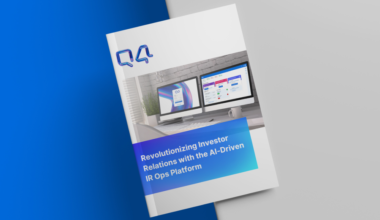Key Takeaways
After 2021 showcased exponential growth in ESG-focused initiatives, investors, executive leadership teams, and heads of state have elevated standards towards broad market and company-specific policy referendums. Long-standing actionable items such as climate change, diverse boardroom composition, and social justice and equity programs draw initial attention from top investment houses, proxy firms, and educational institutions as the discussion heats up in 2022. In this note, Q4 outlines fundamental ESG-focused trends driving policy change and how buy-side investors think about an ESG outlook in 2022.
- Challenges for the financial industry and investors include relying on corporate governance and capital markets to enforce intended change – key questions remain on how stakeholders strike the right balance.
- Increased scrutiny of sustainability standards and policy seen in 2021 will drive innovative reform to a higher level of integrity through third-party governance in 2022.
- Environmental and social principles nearly doubled in proxy voting discussions in 2021, now investors and proxy firms call to action fundamental transitions in long term sustainability planning.
New Policy Guidelines Signal Evolution
Environmental and social shareholder initiatives have taken on heightened attention in 2021, with peak discussions directed toward issuing regulation. Previously, investors and heads of state petitioned for generic sustainability reporting and other ESG-focused disclosures. Now, investors state direct rhetoric surrounding climate-related disclosures like annual emissions reporting and carbon footprint tracking when analyzing corporations.
From a governance standpoint, the International Sustainability Standards Board (ISSB) may provide a draft of global sustainable disclosures for financial markets in early 2022. These guidelines could potentially serve as a catalyst for ESG-focused convergence across countries and administrations.
Social principles, which include board and executive diversity along with data privacy breaches, also gain traction from buy-side investors. In fact, according to S&P Global, shareholder activism increased in 2021 and expects to continue the trend in 2022, “Shareholder activism in this area increased in 2021, including votes against directors for lack of credible climate action plans. This trend is set to pick up speed during the 2022 proxy season. In addition, efforts to diversify boards and create policies that foster meaningful diversity, equity, and inclusion will continue to evolve from a box-ticking approach into a holistic appreciation of how differences in identities, expertise, and leadership styles can drive growth and innovation.” In addition, while the Sustainability Accounting Standards Board (SASB) accepts reporting disclosures on company diversity and inclusion hiring statistics, SASB continues its evolution of expanding diversity and inclusion metrics across further industries (currently not included in all 77) by way of their ongoing Human Capital Project. These disclosures serve as a lead indicator for future employee composition.
Carbon Regulation Takes the Spotlight
The climate is overshadowing governance and social issues at the top of the ESG-focused agenda, reflecting both the existential threat of global temperature rise and the race against time to rein it in. Investors and corporate boards join forces towards net-zero decarbonization through the Sustainability Accounting Standards Board (SASB), which sets industry-standard carbon footprint expectations.
BlackRock, which owns more than 7% of the S&P 500, issued its 2022 Investment Stewardship, including SASB climate reporting as a segment of their investment criteria when evaluating potential capital allocation, “We believe that reporting aligned with the framework developed by the Task Force on Climate-related Financial Disclosures (“TCFD”), supported by industry-specific metrics such as those identified by the Sustainability Accounting Standards Board (“SASB”), can provide a comprehensive picture of a company’s sustainability approach and performance companies to set short-, medium-, and long-term science-based targets, where available for their sector, for greenhouse gas reductions and to demonstrate how their targets are consistent with the long-term economic interests of their shareholders. Companies have an opportunity to use and contribute to the development of alternative energy sources and low-carbon transition technologies that will be essential to reaching net zero.” Proxy firms such as ISS & Glass Lewis have also issued their 2022 proxy voting policies, stating the continuation of tactical support of the TCFD Framework and plans of evaluating management resolutions on a case-by-case basis in this year’s proxy voting.
Board Oversight on Social Initiatives
Explicit oversight by executive leadership teams on material social principles is quickly becoming the standard across the public company universe. Stakeholders seek to link social-related proposals and director election proposals, voting against directors and committee chairs that they believe should be held accountable for perceived governance failures on the core social principles like human capital and social opportunities.
Specifically, human capital focuses on driving increased standards in labor management, human capital development, and labor safety quality. Social opportunities comprise access to communications, finance, healthcare, and health and nutrition. Currently, regulation is limited to government-mandated minimum requirements such as company healthcare offerings and labor safety protocols. However, stakeholders question the value proposition these minimum thresholds offer, which led to a nearly 100% increase in employment-related proxy discussions in 2021, according to Morningstar.
Governance Gluing Together the Sustainability Story
Numerous large companies issued or initiated sustainability goals and released ESG-focused data in 2021. A review of the granularity in some of these reports and disclosures drives greater investor and regulator scrutiny of corporate sustainability efforts, emphasizing what many recognize as greenwashing. Increased criticism derives from concerns companies may be using disclosures and sustainability-related labels on products and services as a vehicle to appear more proactive on sustainability than general standards would prove.
From a governance perspective, regulators like the International Sustainability Standards Board (ISSB) create level-setting regulations with a mind to issuing benchmark disclosures consistent across jurisdictions and industries. These standardizations circle around Global Reporting Initiatives, Task Force on Climate-Related Financial Disclosures, Value Reporting Foundation, Climate Disclosure Standards Board, and the Carbon Disclosure Project.
Fresh global sustainability standards will continue to progress in 2022, aligning the confluence of data, metrics, and reporting issues in both environmental and social principles, which in turn drives pressure to maintain benchmark impacts, not just inputs.
Standardization will be Tested in 2022
A key challenge for market participants in the coming year will be to manage this growth in a way that preserves the legitimacy of financial instruments and combats rising concerns about greenwashing. Indeed, diversification and innovation in sustainable investing and proxy voting are likely to continue, risking greater fragmentation across issuers, investors, sectors, and standards, according to S&P Global. However, the continuous revaluing of sustainability efforts drives greater integrity to issued standards, unifies stronger integrity in 2022 and beyond.


